 To enhance service speed and avoid tariff delays, we've opened a US warehouse. All US orders ship directly from our US facility.
To enhance service speed and avoid tariff delays, we've opened a US warehouse. All US orders ship directly from our US facility.
| Cat. No. | Product Name | Field of Application | Chemical Structure |
|---|---|---|---|
| DC74646 | EB-PSMA-617 Featured |
EB-PSMA-617 is an Evans blue-modified prostate-specific membrane antigen (PSMA) 617 ligand for making 177Lu-EB-PSMA, which is potential useful for Metastatic Castration-Resistant Prostate Cancer.
More description
|
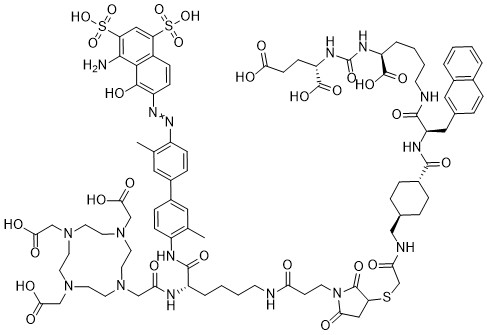
|
| DC74641 | HC-258 Featured |
HC-258 is a Covalent Acrylamide TEAD Inhibitor That Reduces Gene Expression and Cell Migration. HC-258 reduces the CTGF, CYR61, AXL, and NF2 transcript levels and inhibits the migration of MDA-MB-231 breast cancer cells. Co-crystallization with hTEAD2 confirmed that HC-258 binds within TEAD’s PA pocket, where it forms a covalent bond with its cysteine.
More description
|

|
| DC74639 | Oligopeptide-10 Featured |
Oligopeptide-10, also known as granactive oligopeptide-10, is a synthetic bio-active peptide composed of 15 amino acids. it can help manage acne-causing bacteria, both on its own and in conjunction with anti-acne superstar exfoliant salicylic acid.
More description
|

|
| DC73181 | XPW1 Featured |
XPW1 is a potent and selective CDK9 inhibitor with excellent anti-ccRCC activity and low toxicity.
More description
|

|
| DC73996 | FDW028 Featured |
FDW028 is a potent and highly selective small-molecule inhibitor of fucosyltransferase 8 (FUT8) with binding KD value of 5.486 uM, displays no affinity against other FUTs, shows potent anti-CRC activities.
More description
|

|
| DC74638 | GLPG3667 Featured |
GLPG3667 is an oral, reversible, and selective tyrosine kinase 2 (TYK2) inhibitor. It is being developed to treat inflammatory and auto-immune diseases. Biochemical assays showed that GLPG3667 displayed nanomolar potency on TYK2 with a selectivity over other JAK kinases >3-fold. In human PBMC, GLPG3667 showed comparable potency on the IFNα and IL-23 pathways (around 50 nM). Selectivity for TYK2 on the IFNα pathway was >14-fold and >19-fold toward the IL-2 and GM-CSF pathways in human PBMC and whole blood, respectively. Dermal ear inflammation in a mouse model of psoriasis driven by IL-23 was prevented by GLPG3667 with a minimal effective dose of 3 mg/kg given orally once daily. This effect was associated with a decrease in neutrophil infiltration and STAT3 phosphorylation at sites of inflammation. In healthy HV, GLPG3667 completely inhibited IFNα-induced STAT1 and STAT3 phosphorylation but did not impact IL-2- and GM-CSF-induced STAT5 phosphorylation.
More description
|

|
| DC74684 | ZH8667 Featured |
ZH8667 is a trace amine-associated receptor 1 (TAAR1)–Gs agonist.
More description
|

|
| DC22799 | ML-162 Featured |
ML162 is a covalent inhibitor that specifically targets glutathione peroxidase 4 (GPX4), a key regulator of ferroptosis. This compound exhibits selective cytotoxicity against cancer cell lines harboring mutant RAS oncogenes, making it a promising candidate for precision oncology.
More description
|
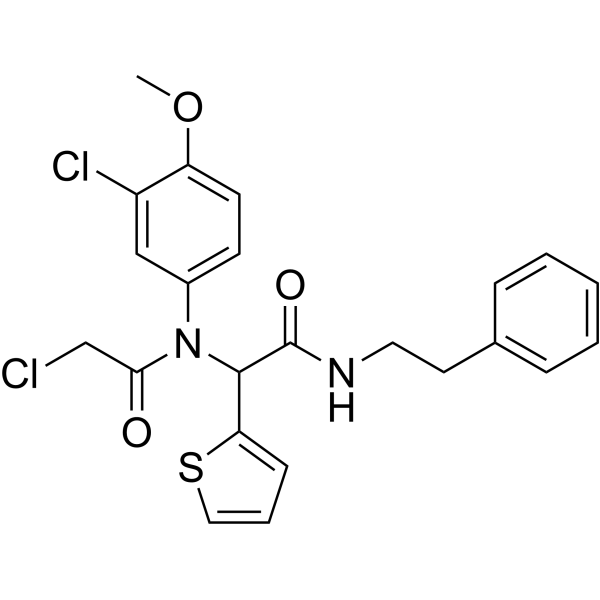
|
| DC70162 | A83B4C63 Featured |
A83B4C63 is a highly potent small-molecule inhibitor targeting the DNA repair enzyme polynucleotide kinase 3'-phosphatase (PNKP), exhibiting strong binding affinity with a Kd of 80 nM. Due to its limited aqueous solubility, A83B4C63 was formulated into nano-encapsulated carriers, enhancing its therapeutic potential—particularly in PTEN-deficient colorectal cancer (CRC).
More description
|

|
| DC11235 | Furamidine dihydrochloride Featured |
Furamidine dihydrochloride (NSC 305831) tyrosyl-DNA phosphodiesterase (Tdp1), also is a selective protein arginine methyltransferase 1 (PRMT1) inhibitor with IC50 of 9.4 uM.
More description
|

|
| DC32456 | Pyrinuron Featured |
Pyrinuron is an inhibitor of NAMPT and NMNAT2.Pyrinuron is used as a model compound in studies of urea derivatives and their reactivity.Research has explored the effects of this compound on insulin-producing beta cells, providing insights into diabetes mechanisms.Although not used therapeutically, this compound’s ability to selectively destroy beta cells has implications for understanding and potentially treating type 1 diabetes.
More description
|
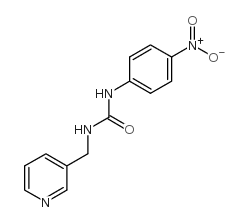
|
| DC31256 | Mifepristone (RU486) Featured |
Mifepristone (RU-486) is a potent steroidal antagonist exhibiting subnanomolar affinity for progesterone receptors (PR IC₅₀ = 0.2 nM) and nanomolar activity against glucocorticoid receptors (GR IC₅₀ = 2.6 nM). This dual-receptor modulator competitively blocks endogenous hormone binding while inducing distinct conformational changes that prevent coactivator recruitment, demonstrating differential antagonism between PR and GR signaling pathways.
More description
|
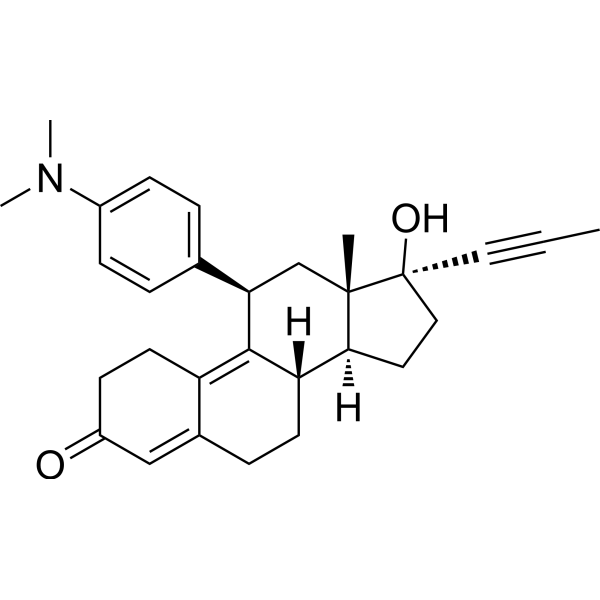
|
| DC74222 | XEN 602 Featured |
XEN-602 represents a breakthrough in DMT1 pharmacology as a picomolar-range inhibitor of divalent metal transporter 1 (SLC11A2), demonstrating unprecedented selectivity for manganese transport blockade (IC₅₀ = 300 pM in HEK293 cells). This structurally optimized small molecule achieves complete suppression of DMT1-mediated Mn²⁺ uptake while maintaining exceptional target specificity, as evidenced by minimal interference with other metal transporters. Its unmatched potency enables precise interrogation of DMT1's physiological roles and therapeutic exploration for manganese dysregulation disorders.
More description
|
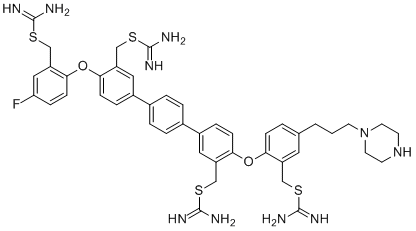
|
| DC10391 | GSK682753A Featured |
GSK682753A is a selective and highly potent inverse agonist of the epstein-barr virus-induced receptor 2 (EBI2) with an IC50 of 53.6 nM.
More description
|
|
| DC34489 | DOCK5-IN-C21 Featured |
DOCK5-IN-C21 functions as an allosteric inhibitor targeting the guanine nucleotide exchange factor DOCK5, effectively modulating its activity through a non-competitive mechanism.
More description
|
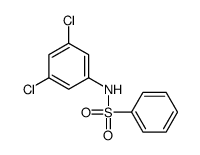
|
| DC12575 | VU0466551 Featured |
VU0466551 is a targeted activator that specifically modulates homomeric G protein-gated inwardly rectifying potassium (GIRK1) channels, demonstrating its selectivity for this ion channel subtype.
More description
|

|
| DC49970 | ZYS-1 Featured |
ZYS-1 has inhibition effect on RNA adenosine deaminase 1(ADAR1), and can be used for preventing and/or treating cancer or tumor-related diseases.
More description
|

|
| DC44186 | Acoramidis Featured |
Acoramidis (AG10) is an orally administered, highly selective kinetic stabilizer effective for both wild-type and V122I-TTR (transthyretin) variants. It is actively investigated as a therapeutic agent in the treatment of transthyretin amyloidosis.
More description
|

|
| DC60814 | Setmelanotide acetate Featured |
Setmelanotide (RM-493, BIM-22493, CAM 4072) is a cyclic peptide full agonist of melanocortin-4 receptor (MC4R) with an EC50 of 0.27 nM and a Ki of 2.1 nM.
More description
|

|
| DC60813 | NPS-2143(SB 262470A ) |
NPS-2143(SB 262470A ) is a selective potent calcium ion-sensing receptor antagonist with IC50 of 43 and 41 nM for cytoplasmic Ca2+ concentrations and parathyroid hormone secretion, respectively.
More description
|

|
| DC60812 | SHA 68 Featured |
SHA 68 is a potent and selective non-peptide neuropeptide S receptor (NPSR) antagonist with IC50s of 22.0 and 23.8 nM for NPSR Asn107 and NPSR Ile107, respectively. SHA 68 has limited the blood-brain barrier (BBB) penetration and the activity in neuralgia.
More description
|

|
| DCC1216 | Carboetomidate Featured |
Analog of etomidate that interacts weakly with 11β-hydroxylase
More description
|

|
| DC70536 | KARI 201 Featured |
KARI-201 is a multifunctional small molecule that demonstrates dual activity as a highly selective inhibitor of acid sphingomyelinase (ASM) and an agonist of the ghrelin receptor. It operates as a competitive inhibitor by binding directly to the active site of ASM. Studies reveal that the incorporation of KARI-201 into ASM decreases in a concentration-dependent manner with sphingomyelin, resulting in KM values of 332.5, 433.9, and 572.6 μM at KARI-201 concentrations of 1, 10, and 100 μM, respectively. In preclinical models, KARI-201 has shown efficacy in reducing amyloid pathology and reversing cognitive deficits in APP/PS1 mice. Additionally, it enhances autophagy degradation by promoting lysosomal biogenesis in neuronal cells. As a ghrelin receptor agonist, KARI-201 also supports hippocampal neurogenesis and improves synaptic plasticity, making it a promising therapeutic candidate for neurodegenerative conditions.
More description
|

|
| DC24079 | DG-172 dihydrochloride Featured |
DG-172 is a cutting-edge compound designed as a selective ligand for PPARβ/δ, exhibiting remarkable binding affinity with an IC50 value of 27 nM. It demonstrates robust inverse agonistic activity, positioning it as a promising candidate for research targeting PPARβ/δ signaling pathways.
More description
|

|
| DC73498 | Ogremorphin Featured |
Ogremorphin (OGM, OGM8345) represents a pioneering small-molecule inhibitor that selectively targets GPR68, demonstrating high specificity with an IC50 value of 0.71 µM. As a first-in-class compound, it offers unique therapeutic potential by precisely modulating GPR68 activity.
More description
|

|
| DC11251 | Casein Kinase inhibitor A86 Featured |
CKIα inhibitor A86 is a groundbreaking pan-specific inhibitor targeting Casein Kinase I (CSNK1), with a remarkable binding affinity (Kd=1-10 nM) and a specific Kd of 9.8 nM for CKIα. Beyond its primary activity, this compound also demonstrates dual inhibitory effects on the transcriptional kinases CDK7 and CDK9. Notably, it exhibits minimal to no inhibition against CDK8, CDK13, CDK11a, CDK11b, and CDK19, highlighting its selective pharmacological profile.
More description
|

|
| DC24063 | Cediranib maleate Featured |
Cediranib maleate (AZD-2171 maleate) is a highly effective, orally administered inhibitor targeting VEGFR with remarkable potency. It demonstrates IC50 values of less than 1 nM for Flt1, below 3 nM for KDR, 5 nM for both Flt4 and PDGFRα, 36 nM for PDGFRβ, and 2 nM for c-Kit, showcasing its broad inhibitory activity across multiple kinase targets.
More description
|

|
| DC70174 | ADAM17 inhibitor SN-4 Featured |
ADAM17 inhibitor SN-4 is a newly identified, highly specific inhibitor of ADAM17 (A disintegrin and metalloproteinase 17), demonstrating potent activity in blocking TNF-α cleavage in cellular assays with an IC50 value of 3.22 µM. This compound exhibits slightly greater efficacy compared to marimastat, a well-established ADAM17 inhibitor. In vitro studies reveal that SN-4 effectively suppresses ADAM17-mediated cleavage of tumor necrosis factor α (TNF-α) and CD44, while showing no significant impact on ADAM10 activity. Additionally, SN-4 has been shown to inhibit cellular invasion, highlighting its potential as a targeted therapeutic agent for modulating ADAM17-related pathways.
More description
|

|
| DC21359 | BHC Featured |
BHC, a small-molecule inhibitor of skeletal muscle myosin, effectively suppresses muscle activity by targeting myosin function without altering membrane currents. This compound emerges from a screening process aimed at identifying molecules capable of modulating muscle movement through myosin inhibition. By specifically inhibiting myosin, BHC provides a unique mechanism for controlling muscle contractions while maintaining the integrity of cellular electrical properties.
More description
|

|
| DC28266 | Furamidine Featured |
Furamidine (DB75) is abisbenzamidine derivative and an antiparasite agent. Furamidine is a potent, reversible and competitive tyrosyl-DNA phosphodiesterase 1 (TDP-1) inhibitor. Inhibition of TDP-1 by Furamidine is effective both with single- and double-stranded DNA substrates but is slightly stronger with the duplex DNA. Furamidine is also a selective and cell-permeable protein arginine methyltransferase 1 (PRMT1) inhibitor with an IC50 of 9.4 μM. Furamidine is selective for PRMT1 over PRMT5, PRMT6, and PRMT4 (CARM1) (IC50s of 166 µM, 283 µM, and >400 µM, respectively).
More description
|

|